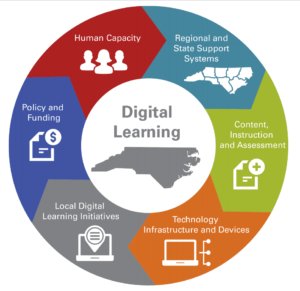

In a recent blog on Jumpstarting Innovation in Education, Melinda Maddox from the Alabama State Department of Education described innovations in her state that exemplify digital-age teaching and learning. In related work in North Carolina, the Friday Institute at NC State University has led the development of the North Carolina Digital Learning Plan, which provides recommendations for continuing and accelerating North Carolina’s transition to digital-age teaching and learning in K-12 schools. The components of this plan are grouped into the six major areas:

In another recent blog, my colleague Mary Ann Wolf described our work addressing the critical human capacity recommendation of providing professional learning for school leaders to help prepare them to lead change processes and support innovating practices in their schools. In this blog, I provide some background on what we mean by digital-age teaching and learning, along with the supports teachers need to become digital-age practitioners of their craft.
As our team traveled the state to observe classrooms and meet with key stakeholders, we found many creative and dedicated educators who are providing innovative, digital-age learning opportunities for their students. We observed students deeply engaged in learning that involved rigorous content, along with collaboration, communication, critical thinking, and creativity (the “4 C’s”). The following table summarizes key elements of these approaches, how they differ from traditional instructional models, and the types of teaching and learning practices.
Some of the elements of digital-age learning reflect approaches that many teachers incorporated long before the advent of the Internet. Recommendations for personalized learning, competency-based advancement, student-centered learning, portfolio assessments, and project-based learning go back many decades and can be found in the writings of many scholars of education. Modern technologies can make these approaches more practical to implement widely and more powerful in impacting students’ learning. Other elements of digital learning— access to anywhere and anytime online learning and to the wealth of interactive digital learning resources—are only possible through the power of the Internet. All of these elements must be brought together in order to provide true digital-age learning experiences for all students.
The transition to digital-age teaching and learning involves changing the culture of teaching and learning. Teachers are no longer the keepers and conveyers of information, but rather the designers of learning experiences that enable students to productively engage with rich resources and learning activities. Teachers also become analysts of students’ learning, using both their direct knowledge of each student and the data that can now be collected and instantly reported online, in order to craft learning experiences that engage students and provide appropriate levels of challenge for each one. They help students become independent learners who can make effective use of anytime, anywhere learning opportunities and engage productively in individual and collaborative projects. They can also harness the power of social networking to enhance learning and to help their students learn how to use it appropriately.
Another critical recommendation of the NC Digital Learning Plan is providing effective professional development to enable North Carolina’s 100,000 educators to update their knowledge, skills and practices. This will require digital learning instructional coaches to work directly with teachers within their schools to model, coach, identify digital learning resources and facilitate professional learning teams. It will require opportunities for teachers to experience themselves being digital-age learners, such as through the use of online courses, MOOCs, and online professional learning communities. It will require administrators who encourage teachers to innovate and support the risk-taking involved in trying new approaches. It will also require time allocated for teachers to engage in ongoing learning as part of the day-to-day professional lives, in order to keep up with the ever changing resources, technologies, and practices of effective digital-age teaching.
While North Carolina has made great progress in providing a digital-age technology infrastructure in our schools – and there are pockets of great innovations throughout the state – we now need to turn our efforts to developing the human infrastructure that can provide all our students with the digital-age teaching and learning opportunities that will prepare them for college, careers and citizenship in the rapidly changing, global, digital world.
(Dr. Kleiman was a panelist and resource expert on digital learning innovation at The Hunt Institute’s December 2016 Holshouser Legislators Retreat: Education for a Stronger North Carolina | Policy, Implementation, and Results. )